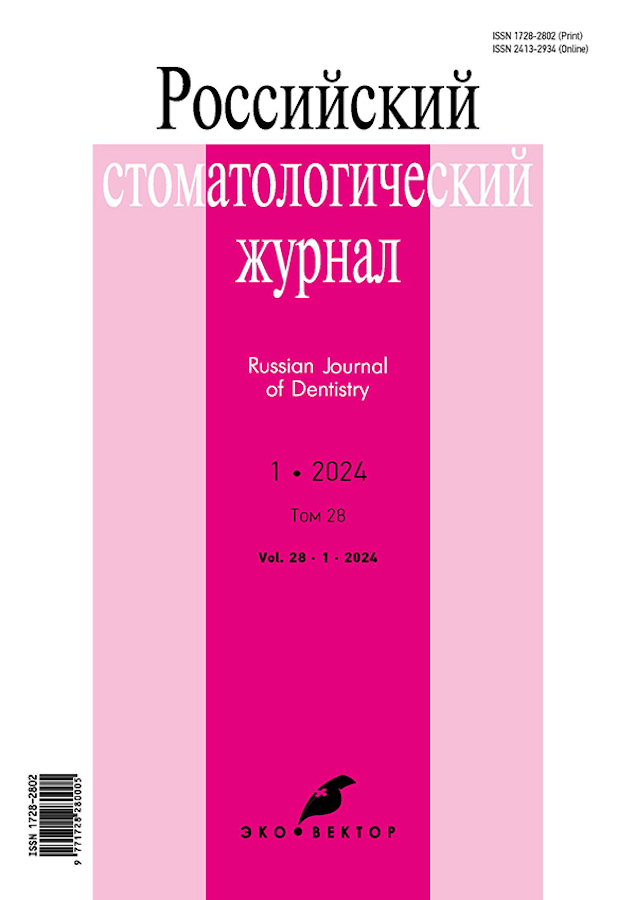Assessment of articulation parameters settings repeatability in Avantis 3D software
- 作者: Kovgan D.S.1, Erokhin V.A.2, Antonik P.M.3, Antonik M.M.3, Saveliev V.V.1, Parunov V.A.1, Oganesyan A.S.4
-
隶属关系:
- Peoples’ Friendship University of Russia named after Patrice Lumumba
- Samara State Medical University
- Russian University of Medicine
- Academician I.P. Pavlov First St. Petersburg State Medical University
- 期: 卷 28, 编号 1 (2024)
- 页面: 99-105
- 栏目: Digital Dentistry
- URL: https://journals.rcsi.science/1728-2802/article/view/264185
- DOI: https://doi.org/10.17816/dent610446
- ID: 264185
如何引用文章
详细
BACKGROUND: The three-dimensional (3D) space of a virtual articulator requires precise adjustment considering individual parameters for the precision work of orthopedic dentists, orthodontists, and dental technicians. A modern solution that includes a virtual articulator is the domestic Avantis 3D software, which simplifies and speeds up functional diagnostics by creating a 3D scene of the patient.
AIM: To compare a repeatability of articulation parameters obtained when adjusting the domestic virtual articulator Avantis 3D using laboratory and intraoral scans of terminal positions of the lower jaw.
MATERIALS AND METHODS: A group of 30 volunteers aged 18–35 years participated in this study. The group consisted of 18 women and 12 men. Each participant underwent a computed tomography of the maxillofacial region, including the temporomandibular joint region in a state of habitual occlusion; one-stage A-silicone impressions were obtained, plaster models were cast, and silicone bite registers of three terminal positions were made. An intraoral scan of the upper and lower jaws was performed, and optical bite scans were obtained in the position of maximum fissure-tubercle contact and in the terminal positions of the lower jaw, fixed by previously obtained silicone registers. The same protocol was conducted for plaster models of the patient’s dentition and silicone registers of terminal positions. Using intraoral scans, optical recorders of terminal positions and computer tomograms in the Avantis 3D program and 3D scenes were created, and a virtual articulator was configured.
For each patient, the virtual articulator was adjusted in the Avantis 3D software, seven times using data from the intraoral scanner level and seven times from the laboratory level.
The reproducibility of articulatory parameters was assessed for all types of scans obtained, examining the standard and individual intercondylar distances for each patient.
RESULTS: The average values of the standard square deviation of articulatory parameters obtained when creating 3D scenes using laboratory scans at individual and standard intercondylar distances were higher than the similar values obtained using intraoral scans.
CONCLUSION: The accuracy of creating a virtual copy of a patient can be influenced by several factors: the error in combining scans, repeated scanning, the error in combining scans and computer tomograms, the error in combining jaw and bite scans, and the presence of penetrating occlusal contacts between scans of the dentition.
作者简介
Dmitry Kovgan
Peoples’ Friendship University of Russia named after Patrice Lumumba
Email: megaspayn@mail.ru
ORCID iD: 0009-0000-2390-0413
SPIN 代码: 3243-8270
俄罗斯联邦, Moscow
Vladislav Erokhin
Samara State Medical University
编辑信件的主要联系方式.
Email: vladalex.171097@mail.ru
ORCID iD: 0000-0003-1096-7568
SPIN 代码: 4724-5883
俄罗斯联邦, Samara
Pavel Antonik
Russian University of Medicine
Email: wow-oop@yandex.ru
ORCID iD: 0000-0001-5262-6679
SPIN 代码: 7892-3432
俄罗斯联邦, Moscow
Mikhail Antonik
Russian University of Medicine
Email: wow-oop@yandex.ru
ORCID iD: 0000-0001-7902-1215
SPIN 代码: 8713-4695
MD, Dr. Sci. (Medicine), Professor
俄罗斯联邦, MoscowVasiliy Saveliev
Peoples’ Friendship University of Russia named after Patrice Lumumba
Email: bazilsav@gmail.com
ORCID iD: 0000-0003-0437-1290
SPIN 代码: 9363-9779
俄罗斯联邦, Moscow
Vasiliy Parunov
Peoples’ Friendship University of Russia named after Patrice Lumumba
Email: vparunov@mail.ru
ORCID iD: 0000-0003-2885-3657
SPIN 代码: 8797-6513
MD, Dr. Sci. (Medicine), Professor
俄罗斯联邦, MoscowArtak Oganesyan
Academician I.P. Pavlov First St. Petersburg State Medical University
Email: Artac@yandex.ru
ORCID iD: 0009-0009-5127-7847
SPIN 代码: 3051-2946
俄罗斯联邦, Saint Petersburg
参考
- Baldissara P, Koci B, Messias AM, et al. Assessment of impression material accuracy in complete-arch restorations on four implants. J Prosthet Dent. 2021;126(6):763–771. doi: 10.1016/j.prosdent.2020.10.017
- Ryahovsky AN, Muradov MA, Erokhin VA. Lower jaw virtual reposition accuracy research. Stomatologiya. 2022;101(4):53–60. EDN: KVGLBG doi: 10.17116/stomat202210104153
- Ryakhovsky A, Ryakhovsky S. A new concept of 4d virtual planning in dentistry. Advances in Dentistry & Oral Health. 2020;12:00214. doi: 10.19080/ADOH.2019.11.555832
- Patent RUS N 2567604 C2/10.11.2015. Christensen KK, Fisker R, Bart KV, Poul’sen TS. Dynamic virtual articulator. EDN: HDZUWS doi: 10.1134/S0040363615100100
- Chkhikvadze ТV, Bekreev VV, Roshchin ЕМ, et al. Correction of internal disorders of the temporomandibular joint using muscle relaxation splints made with CAD/CAM technologies. Sovremennye tehnologii v medicine. 2019;11(3):111–116. EDN: KFXJYB doi: 10.17691/stm2019.11.3.15
- Subeihi H, Hirayama H, Finkelman M, et al. Comparison of dimensional accuracy of digital dental models. In: Proceedings of the IADR/AADR/CADR General Session and Exhibition 2013; March 2013; Seattle, Washington. Available from: https://www.researchgate.net/publication/266777620_Comparison_of_Dimensional_Accuracy_of_Digital_Dental_Models
- Diker B, Tak Ö. Comparing the accuracy of six intraoral scanners on prepared teeth and effect of scanning sequence. J Adv Prosthodont. 2020;12(5):299–306. doi: 10.4047/jap.2020.12.5.299
- Ryahovsky AN. Assessment of supracontacts size at digital positioning of scans in habitual occlusion. Stomatologiya. 2021;100(3):60–64. EDN: VKFZNG doi: 10.17116/stomat202110003160
补充文件









